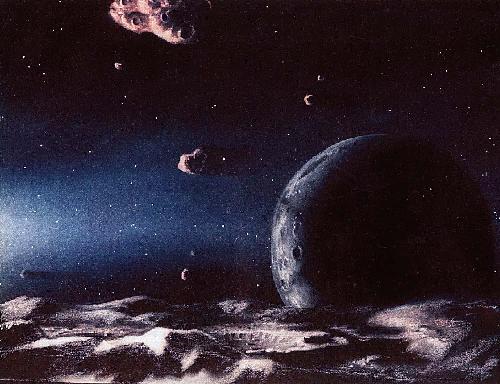
Crystalline State of the Ice
Crystalline vs. Amorphous Ice
These terms refer to the geometric arrangement of the molecules in the solid state form of water (ice).
Crystalline ice consists of water molecules arranged in a geometrically repeating pattern, either cubic or hexagonal. Almost all of the ice you see in the natural environment of Earth (e.g. in snow, your freezer, in the polar caps) is crystalline ice.
Amorphous ice consists of water molecules arranged in a disordered state, with no large scale regularity to their orientations or positions. This kind of ice is most often found in space.
(Actually, examples of crystalline and amorphous solids are common in everyday life, just not in water ice. Glass, for example, is amorphous silicon dioxide while quartzite is the same material but in crystalline form)
For our purposes, the distinction between the two types matters because it reveals something about the temperature history of the ice. At low temperatures, the water molecules freeze where they collide, forming the characteristic higgledy-piggledy structure of amorphous ice. At high temperatures (but still below the freezing point, obviously) the molecules retain sufficient thermal energy after impact that they can jiggle and scoot around until they fit into a minimum-energy configuration with respect to the adjacent molecules. This is crystalline ice.
Why Do We Care?
For two main reasons:
First, crystallization is
exothermic. It releases about 90,000 J/kg.
This energy may be very important in determining the heat budget of a
cold body.
Second, the nooks and crannies in amorphous ice provide excellent
hiding places for other molecules. Amorphous ice can trap substantial
masses of other material in a sponge-like way. Trapping efficiency
varies exponentially with inverse temperatures. This means that,
when amorphous ice transforms, one should expect to observe a pulse
of expelled molecules that were formerly esconced in the amorphous
ice structure.
How Do We Tell The Difference?
As astronomers, we have to do everything from a distance, so we use the
reflection spectrum to discriminate amorphous from crystalline ice. The
aborption band wavelengths and shapes differ slightly between the two
forms. Most crucially, a band near 1.65 micron wavelength is only
produced in crystalline ice. If you see it, the ice is crystalline.
See this
example.
Effect of Temperature History
Amorphous ice transforms spontaneously to crystalline ice at a rate
that is highly temperature dependent. At temperatures above about 77K,
the transformation timescale is less than the age of the Solar system.
Therefore, except for the very coldest places (e.g. in the Kuiper belt) we
should expect to see that the ice is crystalline, regardless of how it
formed. This is in accordance with
what we observe
. However, the
reverse does not apply: crystalline (high temperature) ice does not
convert to amorphous when its temperature is lowered. The reason for
this asymmetry is that crystalline ice is already in a minimum energy
configuration, so dropping the temperature (think: random, thermal
motions) of the molecules can do nothing to change their geometrical
arrangement.
Effect of Energetic Radiation
Energetic radiation (particles like electrons and protons found in the
solar wind and cosmic rays and photons like UV and X-rays) can
transform crystalline ice into amorphous ice. This occurs because the
radiation breaks the bonds which hold the molecules in their repeating
patterns in crystalline ice. At high temperatures, the effect is small
and transient because vibrational motions of the molecules jiggle them
back to the ordered (crystalline) state. At low temperatures, though,
the damage done by radiation does not heal, and ice will eventually be
completely transformed into the amorphous state. How long this takes in
the Kuiper Belt is somewhat uncertain, but probably about 10 million
years or less.
 Kuiper Belt
Kuiper Belt
